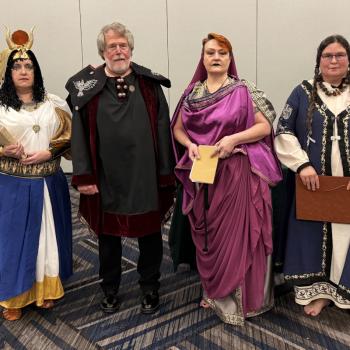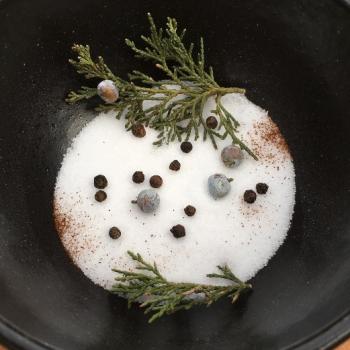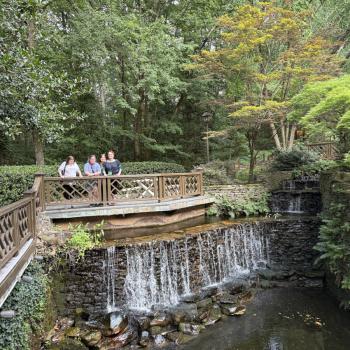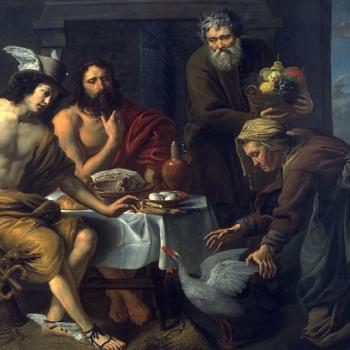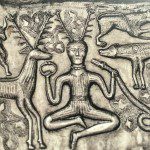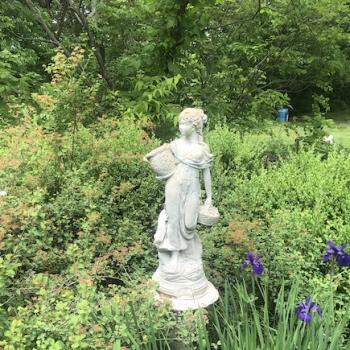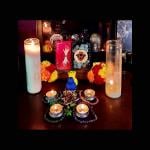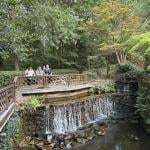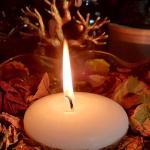(I thought writing on the road would be easy, I was wrong. I probably made things harder on myself by leaving my laptop at home and only taking my Ipad and a keyboard. I like my Ipad, but it’s not very good at pointing out misspelled words. WordPress won’t allow me to paste things written on my word processor either, so I’m sure this post will have lots of typos and other things wrong with it. I apologize in advance, but at least you’ve been warned. Now onto actual Pagan things.)
Last night I was interviewed by a graduate student working on a paper about Pagan Festivals. She’s actually been researching her paper for about two years now, and has immersed herself in the Pagan Festival experience during that time. I think I learned more from listening to her questions than she learned from me answering them, but I gave it my best shot.
One of the observations that came up in our conversation was just how much Pagan Festivals (and Pagandom in general) are about re-creation. I’m currently at the Starwood Festival and all around me there are people in various states of undress, men in sarongs, and women in tie-dye. If someone were to take a random picture of this festival and show it to Jane Q Public they’d think it was a hippy festival. In many ways Pagan Festivals are hippy festivals. A lot of lip service is given to the environment,* there are drum circles, substances beyond alcohol are probably used, and most everyone lives in a tent for a week. My little brother used to go to Rainbow Gatherings, and he often couldn’t tell the difference between a Pagan Festival and a Gathering.
There are a whole host of reasons your average (outdoor**) Pagan Festival feels like a gathering of Woodstock Refugees. The most obvious reason is because the people who started the Pagan Festival circuit grew up in the 1960’s. Paganism really took off in the States during the 60’s, and the festival scene emerged in the 1970’s. Many of the organizers were hippies, so festivals became infused with that spirit.
When it comes to finding a “Pagan Spirit” the 60’s certainly aren’t a bad place to start. The music is pretty good, and the whole “peace and love” thing fits in nicely with the average Pagan worldview. Considering the high level of polyamorous and open relationships in the Pagan Community (compared to the public at large, and not every Pagan is polyamorous, nor should they be) “free love” is another selling point.
What’s surprising is that the hippy vibe of the 70’s Pagan Festival scene is still alive and well. Some of that is because the people who first started the festival scene thirty years ago are still at it. If it’s not broken, why fix it? There are other folks, like myself, who missed out on the 60’s and 70’s and grew up wanting to live in the era of Hendrix and Joplin. I grew up in the world of Ronald Reagan, “Just Say No,” and the specter of AIDS. I went to college in the 90’s, and while it was a little better, the grunge scene certainly wasn’t “Come on people now, smile on your brother, everybody get together and try to love one another right now.” (Kurt Cobain even mocked those lyrics on “Nevermind,” and if you don’t know who Kurt Cobain was I can’t help you.)
After all of that why wouldn’t we romanticize the 60’s? Compared to the last few decades it seems like a dreamscape, and while I know that’s not necessarily true, the idea of the 60’s seems worthy of trying to relive. I want a world that feels like it’s attempting to live up to the idea of “perfect love and perfect trust.” The 60’s were flawed, but you always got the sense that they were at least trying. I don’t want to dismiss everything that’s happened in the last thirty years, but sometimes it doesn’t feel like we are as engaged (or as outraged) as were forty years ago.
So in some ways the average hippy filled Pagan Festival is like going to 60’s Disneyworld. It’s a chance to walk around naked, smile at people, drum until morning, and engage in the ocassional dalliance. It’s a chance to escape the bonds of mundania and live how you want to live, which is especially liberating when how you want to live is generally looked down up by society at large. For some people this is probably very unappealing (and there are parts of it that bother me, we have showers here-use them), but for those it appeals to it’s no wonder why those folks call various Pagan Festivals they attend “home.” (For me, home is where my stuff is, but I understand the sentiment.)
Romanticizing the past is nothing new in Paganism. When Modern Paganism was finding traction in the 1950’s it also engaged in wistful longings for a past era (and the past that it romanticized is still a part of Pagandom to this day). A lot of 50’s and 60’s Paganism tried to recreate the idea of the eternal English countryside, a world where villagers in the hinterlands still practiced Paganism while winking at the local church as they marched by it on Beltane. Considering the horrors of World Wars I and II and the Great Depression the romanticization of that era is (again) not surprising. People always like to remember “the good old days” and then embellish them to make those days even better.***
The romanticization of the late Victorian Era has continued down to the present day. There’s a reason a lot of people like “Steampunk” so much, it presents a world similar to ours (hot water!) but a world big enough that it still has some mystery in it. It’s easier to believe that fairies might buzz around your hedgerow, harder to believe that they might play in the bushes in front of your townhouse. Similarly, it’s easier to see the Horned God when you are surrounded by trees and skyclad Pagans; harder to see him in downtown Manhattan.
Starwood is unique among Pagan Festivals (that I’ve been to) in that it has a very visible “rave” element to it. I think that’s going to be another step on the Pagan Evolutionary chain. I’m not a huge rave person myself, but I can see the appeal of a dance floor acting as one huge organism. You can find a lot of that 60’s era vibe in that scene as well, and I think it’s a pretty natural fit into the world of Pagan Festivals, even if it’s meeting a lot of resistance from some segments of the community.
Now that I’ve spent the last two hours reflecting on Pagan Festivals I should probably go live a Pagan Festival, or at least be sociable. Besides, it’s probably time for me to put on a sarong so I fit in a little better.
*I say lip service because there’s always an element at festivals who refuse to recycle, throw cigarette butts onto the ground, and generally behave in a way that I think runs counter to the idea of being an “environmental steward.” Those folks are certainly in the minority, but they are around.
**I say “outdoor” because indoor festivals feel much less “hippyish.” There’s still a level of hedonism, but a lot less naked people.
***Conservatives have done the the same thing with the 1950’s. Apparently McCarthyism, segregation, and “Leave it to Beaver” are worthy of waxing nostalgic on.




